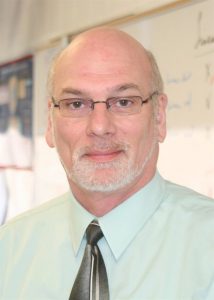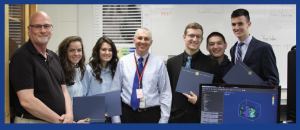We are excited to have the opportunity to talk to Dr. Victor Pinks II, CAE Workforce/Education Integrator for Businesses at Marmion Academy. Dr. Pinks created a new type of business-centric CAE workforce/education curriculum model that has been live tested since 2013 as CPARC (Computational Prototyping And Research Center). Learn more about this special program and the impact it’s making on businesses.
Please tell us your name, title, and what you are responsible for at Marmion Academy.
My name is Dr. Victor Pinks II. In addition to being IT Director and Science Chair, I am the Founder/Director of the CPARC Engineering Center.
Tell us a little bit about your career path. What made you decide to pursue a career in chemistry/chemical physics? In addition, how did you end up teaching/in academia?
Wow…that’s a big question, but I will try to summarize it. Basically, it’s like anyone. You have an idea where you want to go and then reality steps in. In high school, I wanted to be an airline pilot then a rock star. I did get a pilot’s license and started college as a music major. That didn’t last long because I only wanted to play guitar, not to become a band director. And so, I did what most undecided young adults do, I quit college and went to the school of life. I joined a band, had an agent, and learned that playing in bars is not as glorious as it appears. Fortunately, I was on a leave of absence from my job working in a psychiatric hospital which had a big medical aspect. After 3 months of the band, I put music as a secondary passion.
In psychiatry, you really learn how to communicate, and the medical aspect only drove me more to wonder why the medications were able to make such an impact on a person’s state of mind. I was hooked and decided to go back to college, starting over as a pre-med major. Having worked in a hospital it wasn’t technical enough for me. I wanted to know ‘why’ the medications worked and switched to chemistry as a major (I kept working at the psychiatric hospital because it was fun work from a humanity aspect – besides, it paid well and was stable). Eventually, I graduated with a B.S. in chemistry and knew I had to keep pushing. I received my Ph.D. in chemical physics (the physics of chemistry) by writing molecular dynamics (MD) solvers for simulations.
So here is where it gets real. How I ended up in academia was not the original plan. While I was in graduate school my late wife had a stroke after only four years of marriage. I decided that I would focus on commercializing my MD solvers once I graduated and try to build a future that way. We both needed me to finish and push through. It worked out better that I move to computational chemistry so that I could work remotely when possible and still care for her. Although it took a few years longer (worked multiple jobs, etc.) I did finish. My hardships were a blessing in a way. I was forced toward business and learned a lot about what was needed to raise funding, venture capitalists, intellectual property, and so on. I was mentored by many successful business people and started understanding their pains. If you put the recession in the backdrop, home care for my disabled wife, superimposed with the newness of computational chemistry as a discipline, you can understand why it was difficult to find an industrial job in MD in the early 1990s that would work with my situation.
Nonetheless, MD was a relatively new discipline that would only become more ubiquitous in the future. And so, having an opportunity to teach chemistry at my alma mater, Marmion Academy, I jumped on it. Most importantly, I was promised and had incredible flexibility with technology, science, and decision-making. To me, this was what I needed to extend my efforts to commercialize my MD solvers and push forward. One condition of employment was that I teach AutoCAD so I used my limited experience and kept about 3 months ahead of the students by taking an evening course at a local community college. I eventually taught AutoCAD for 8 years, worked on commercializing my MD, and was able to care for my wife until her passing in 2007.
It was during these difficult days that I did a ‘deep dive’ into artificial intelligence and connecting molecular solvers with CFD. I had the right training and situation to develop it. I started seeing a convergence of CFD and MD viscosity calculations. This was when the idea of CPARC came to me. Keeping a close eye on business, I learned about their problems and hesitations with any type of simulation. Computational chemistry suffers from the same misunderstandings. And so, that’s how I ended up in academia. It was the result of following a commercial pathway but getting diverted into academia due to circumstances. One thing that has stayed with me was my 23 years working in psychiatry. I learned about people and their motivations. Most of all, the value of good communication skills. I am comfortable talking with almost anyone about pretty much anything.
At Marmion, you are the director of the Computational Prototyping and Research Center (CPARC). Tell us about this special program, its history, and why it is so important to students and businesses alike.
As I mentioned earlier, I had learned a lot about business needs from failed attempts to commercialize my MD solvers. However, I knew I was on to something when a venture capitalist offered me a seven-figure amount of money for my software that was not user-friendly. I realized that he was playing a numbers game, but I didn’t want to take that chance with my life situation. I needed my venture to succeed. I decided to push the convergence of CFD and MD by calculating viscosity values from molecular solvers. I met no resistance from Marmion Academy but rather glassy-eyed nodding when I would discuss this as engineering of the future. I knew that I had to bring students into this convergence through CAE.
I was following XFlow and I knew about lattice gases and their importance in simulation modeling turbulence. The recession created a lot of suffering for businesses, yet there was one group of people that kept pushing simulation and computing power for the masses. Yes, it was the gamers! They kept pushing for more computing power and showed the world that high school students could maneuver through the computing world if adults would stop telling them what they could and couldn’t learn – adults needed to simply ‘get out of the way.’ I asked my students, “If your most difficult video game is rated a ten (in difficulty), then what is XFlow?” Most replied, “A seven.” I was floored and curious how this was possible. They explained – with their video game they cannot look up the answer but with XFlow the solution is online. The easier the user interface is for XFlow, the easier it became for students to move through – regardless of the content.
I had to accept that XFlow (and eventually Abaqus) would create a new learning context where I would teach science. Of course, you have basic prerequisites, but they are not anything a high school student cannot know. It became a new type of experiential learning – much like we do naturally. The real question is to the instructor. Are they comfortable being a ‘guide on the side?’ It also helps have a first-principles understanding of CAE and molecular simulations and that is probably needed to guide the program in the long term, but not necessarily day-to-day. It’s this new type of business-centric CAE curriculum that does most of the work. It considers the high financial risks of businesses trying to innovate and/or update their product lines in the digital realm. For students, recognition is most important. For businesses, the CAE workforce.
What is CPARC’s mission statement and what makes it different from other STEM programs?
To provide an experiential learning environment for CAE that benefits both business and education. What’s different is that CPARC will only accept the projects that those businesses are working on and will learn what is necessary to contribute to their solution.
What has been a standout project or opportunity that CPARC has been a part of?
There are several. One large one is federal, but I cannot discuss the specifics of that. We did a deep-sea ROV umbilical cable – that was neat. The one that we are very proud of and currently involved with is hypersonic aerospace design optimization for Velontra. We find that with most projects, we cannot get enough computing speed. We are working with XSEDE to test XFlow on high-performance computing assets using a 1000 GPU supercomputer. Students will be rewriting the XFlow tutorials for users.
Are there plans for replicating CPARC at other institutions?
They have been in the works for several years. I have other high schools clamoring to become a CPARC also. It will happen – hopefully sooner than later.
What do you think the future holds for CPARC?
CPARC will become a new model for business/education collaboration that works for all parties. It is the catalyst that CAE needs right now. It was built for the new economy.
What Dassault Systèmes software are you using and how long have you been using it?
Our bread and butter are XFlow and Abaqus since 2016. We’ve used SolidWorks since 2013. We have CST Suite for occasional E&M projects over the past 5 years.
What role does simulation play in helping CPARC do its work?
CPARC is all about virtual simulation and design optimization.
Have you learned anything through working with simulation that you did not expect?
A simulation does not have to be an ideal Digital Twin to be useful. I believe that the concept of ‘Digital Twin’ may be detrimental to CAE because it implies that a perfect ideal model is attainable. That is not true except in theory. What seems to be happening is frustration with the goal of not being able to create a Digital Twin. I worry that, if this ideal is not reached, then these false expectations will lead to unnecessary frustrations with the real value of CAE as a guide. It is best to use the more correct term ‘Digital Model.’
What piece of advice would you give to a young person who is interested in engineering?
There’s nothing more exciting than moving from the fantasy world of video games to the real world of virtual prototyping- where the stakes are real.
What is the most interesting thing about you that we would not learn from your resume?
I used to be a carpenter’s apprentice and love working with wood.
SIMULIA offers an advanced simulation product portfolio, including Abaqus, Isight, fe-safe, Tosca, Simpoe-Mold, SIMPACK, CST Studio Suite, XFlow, PowerFLOW, and more. The SIMULIA Community is the place to find the latest resources for SIMULIA software and to collaborate with other users. The key that unlocks the door of innovative thinking and knowledge building, the SIMULIA Community provides you with the tools you need to expand your knowledge, whenever and wherever.


